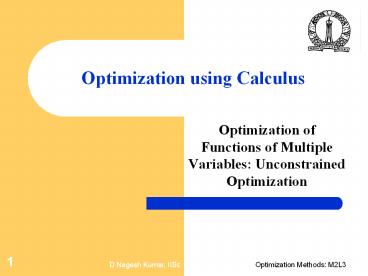Optimization using Calculus - PowerPoint PPT Presentation
1 / 10
Title:
Optimization using Calculus
Description:
Optimization using Calculus Optimization of Functions of Multiple Variables: Unconstrained Optimization Objectives To study functions of multiple variables, which are ... – PowerPoint PPT presentation
Number of Views:176
Avg rating:3.0/5.0
Title: Optimization using Calculus
1
Optimization using Calculus
- Optimization of Functions of Multiple Variables
Unconstrained Optimization
2
Objectives
- To study functions of multiple variables, which
are more difficult to analyze owing to the
difficulty in graphical representation and
tedious calculations involved in mathematical
analysis for unconstrained optimization. - To study the above with the aid of the gradient
vector and the Hessian matrix. - To discuss the implementation of the technique
through examples
3
Unconstrained optimization
- If a convex function is to be minimized, the
stationary point is the global minimum and
analysis is relatively straightforward as
discussed earlier. - A similar situation exists for maximizing a
concave variable function. - The necessary and sufficient conditions for the
optimization of unconstrained function of several
variables are discussed.
4
Necessary condition
- In case of multivariable functions a necessary
condition for a stationary point of the function
f(X) is that each partial derivative is equal to
zero. In other words, each element of the
gradient vector defined below must be equal to
zero. i.e. the gradient vector of f(X),
at XX, defined as follows, must be equal to
zero
5
Sufficient condition
- For a stationary point X to be an extreme point,
the matrix of second partial derivatives (Hessian
matrix) of f(X) evaluated at X must be - positive definite when X is a point of relative
minimum, and - negative definite when X is a relative maximum
point. - When all eigen values are negative for all
possible values of X, then X is a global
maximum, and when all eigen values are positive
for all possible values of X, then X is a global
minimum. - If some of the eigen values of the Hessian at X
are positive and some negative, or if some are
zero, the stationary point, X, is neither a
local maximum nor a local minimum.
6
Example
- Analyze the function
- and classify the stationary points as maxima,
minima and points of inflection - Solution
7
Example contd.
8
Example contd.
9
Example contd.
10
Thank you































